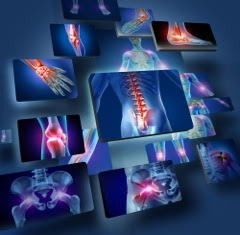 While African American women tend to have a higher bone density than white women throughout their lives, they are still at a significant risk of developing issues related to bone and joint health. These terms may not be used as often in our community; however, complications can surface in the form of arthritis, joint pain, and carpal tunnel syndrome. The misconception that “osteo” related health concerns aren’t of concern to black women can cause some to fail to properly treat underlying conditions.
While African American women tend to have a higher bone density than white women throughout their lives, they are still at a significant risk of developing issues related to bone and joint health. These terms may not be used as often in our community; however, complications can surface in the form of arthritis, joint pain, and carpal tunnel syndrome. The misconception that “osteo” related health concerns aren’t of concern to black women can cause some to fail to properly treat underlying conditions.
Few women know that more than Dorothy Spear of Detroit, Michigan. After years of working for the grocery chain A&P (later known as Farmer Jack), she began to notice the negative effects of the repetitive use of her hands when handling groceries. Yet, even after having to leave her job, she had no idea how serious the problem would become.
It wasn’t until she took another job that required walking and standing for as long as 8 hours a day that she realized something wasn’t right. Beyond her work limitations, even the simplest of tasks became challenging.
“Lifting, getting up out of a chair, walking, and just general movement,” are some of the activities Spear said gave her trouble. “Getting out of bed in the morning, I was always stiff and aching as soon as my feet hit the floor.”
 Bone health may be widely underestimated in the black community; however, there are several ways it can keep us from doing the simplest of activities we take for granted. Medical Administrator Pamela McKee explains the most common bone and joint diseases affecting African Americans include Rheumatoid Arthritis, Osteoporosis, Osteoarthritis, Rickets and Paget’s Disease.
Bone health may be widely underestimated in the black community; however, there are several ways it can keep us from doing the simplest of activities we take for granted. Medical Administrator Pamela McKee explains the most common bone and joint diseases affecting African Americans include Rheumatoid Arthritis, Osteoporosis, Osteoarthritis, Rickets and Paget’s Disease.
“Depending on the early signs of these diseases, [it] could be swelling, pain in the joints, and stiffness, especially after laying down or sitting or typing all day, unable to ambulate well, weakness and fatigue, tenderness and feeling ill.” Mckee said.
The big question of what actually causes bone and joint pain is somewhat of a mystery. However, it can be attributed to several factors such as an injury, strenuous activity, and even genetics.
“It could be just the normal everyday wear and tear of using your joints to the point that the cartilage just breaks downs,” McKee said. “A knee or back injury can later cause arthritis, or there could be a family history of such.”
While no certified plan exists to prevent arthritis, it is important to remain conscious of healthy habits. Pamela McKee suggests there are numerous treatments for arthritis. She also stressed that one of the most important things to do is see your primary doctor and/or seek the referral of a rheumatologist.

Patients like Dorothy Spear have taken the proactive approach. She sought medical treatment to get to the bottom of her bone and joint pain. Spear ended up seeing a specialist who diagnosed her with arthritis and a pinched nerve. With the help of physical therapy and medication, she was able to mitigate the effects of the disease. Spear also credits exercise, maintaining a healthy diet, and even over-the-counter prescriptions for helping her manage arthritis and joint pain.
While sufferers of bone and joint paint may no longer be able to handle strenuous activity, they can maintain active, productive lives. Dorothy Spear has since returned to the jobforce; but, now she recognizes her limits. After attacking her diagnosis head on, it no longer keeps her from doing the things she wants and needs to do.
“What I’ve learned is that you must move, you’ve got to get up and walk, regardless of the discomfort,” Spear said. “You’ve got to do some type of exercise, even if it’s minimal, and make sure you’re not sitting all day.”
By watching what she eats, monitoring sugar intake, and eliminating certain foods, Dorothy Spear has taken control over her life in the fight against bone and joint pain. She also credits a pineapple as a fruit with miraculous results.
At the end of the day we cannot control what ailments we might face, but we can control our response.
“We have no control over falls, family history or an individual’s lifestyle such as weight gain, exercise, vitamins or our body,” said McKee. “All we can do is try to live a healthy lifestyle.
